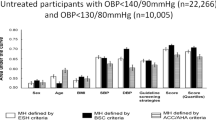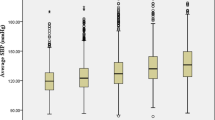Abstract
This study aimed to assess the reliability of opportunistic screening programs in estimating the prevalence, treatment, and control rate of hypertension in the general population. Two recent epidemiological surveys obtained data on hypertension in the adult general population in Greece. The EMENO (2013–2016) applied a multi-stage stratified random sampling method to collect nationwide data. The MMM (2019) collected data through opportunistic (voluntary) screening in five large cities. Hypertension was defined as blood pressure (BP) ≥ 140/90 mmHg (single occasion; average of 2nd–3rd measurement; electronic devices) and/or use of antihypertensive drugs. Data from a total of 10,426 adults were analyzed (EMENO 4,699; MMM 5,727). Mean age (SD) was 49.2 (18.6)/52.7 (16.6) years (EMENO/MMM, p < 0.001), men 48.6/46.5% (p < 0.05) and body mass index 28.2 (5.7)/27.1 (5.0) kg/m2 (p < 0.001). The prevalence of hypertension in ΕΜΕΝΟ/MMM was 39.6/41.6% (p < 0.05) and was higher in men (42.7/50.9%, p < 0.001) than in women (36.5/33.6%, p < 0.05). Among hypertensive subjects, unaware were 31.8/21.3% (EMENO/MMM, p < 0.001), aware untreated 2.7/5.6% (p < 0.001), treated uncontrolled 35.1/24.8% (p < 0.001), and treated controlled 30.5/48.3% (p < 0.001). In conclusion, the prevalence of hypertension was similar with random sampling (EMENO) and opportunistic screening (MMM). However, opportunistic screening underestimated the prevalence of undiagnosed hypertension and overestimated the rate of hypertension treatment and control. Thus, random sampling national epidemiological studies are necessary for assessing the epidemiology of hypertension. Screening programs are useful for increasing awareness of hypertension in the general population, yet the generalization of such findings should be interpreted with caution.
This is a preview of subscription content, access via your institution
Access options

Similar content being viewed by others
References
NCD Risk Factor Collaboration (NCD-RisC). Worldwide trends in blood pressure from 1975 to 2015: a pooled analysis of 1479 population-based measurement studies with 19·1 million participants. Lancet. 2017;389:37–55.
European Cardiovascular Disease Statistics 2017 edition. European Heart Network AISBL, Rue Montoyer 31, B-1000 Brussels, Belgium. 2017; http://www.ehnheart.org/cvd-statistics/cvd-statistics-2017.html. Accessed 16 Sep 2020.
Mills KT, Bundy JD, Kelly TN, Reed JE, Kearney PM, Reynolds K, et al. Global disparities of hypertension prevalence and control: a systematic analysis of population-based studies from 90 countries. Circulation. 2016;134:441–50.
World Health Organization. A global brief on hypertension: silent killer, global public health crisis. World Health Day 2013. 2013; www.who.int/cardiovascular_diseases/publications/global_brief_hypertension/en/. Accessed 16 Sep 2020.
Wolf-Maier K, Cooper RS, Banegas JR, Giampaoli S, Hense HW, Joffres M, et al. Hypertension prevalence and blood pressure levels in 6 European countries, Canada, and the United States. JAMA. 2003;289:2363–9.
Wolf-Maier K, Cooper RS, Kramer H, Banegas JR, Giampaoli S, Joffres MR, et al. Hypertension treatment and control in five European countries, Canada, and the United States. Hypertension. 2004;43:10–7.
Leung AA, Williams JVA, McAlister FA, Campbell NRC, Padwal RS. Hypertension Canada’s Research and Evaluation Committee. Worsening hypertension awareness, treatment, and control rates in Canadian women between 2007 and 2017. Can J Cardiol. 2020;36:732–9.
Bielecka-Dabrowa A, Aronow WS, Rysz J, Banach M. The rise and fall of hypertension: lessons learned from Eastern Europe. Curr Cardiovasc Risk Rep. 2011;5:174–9.
Stergiou GS, Thomopoulou GC, Skeva II, Mountokalakis TD. Prevalence, awareness, treatment, and control of hypertension in Greece: the Didima study. Am J Hypertens. 1999;12:959–65.
Panagiotakos DB, Pitsavos CH, Chrysohoou C, Skoumas J, Papadimitriou L, Stefanadis C, et al. Status and management of hypertension in Greece: role of the adoption of a Mediterranean diet: the Attica study. J Hypertens. 2003;21:1483–9.
Sarafidis PA, Lasaridis A, Gousopoulos S, Zebekakis P, Nikolaidis P, Tziolas I, et al. Prevalence, awareness, treatment and control of hypertension in employees of factories of Northern Greece: the Naoussa study. J Hum Hypertens. 2004;18:623–9.
Psaltopoulou T, Orfanos P, Naska A, Lenas D, Trichopoulos D, Trichopoulou A. Prevalence, awareness, treatment and control of hypertension in a general population sample of 26,913 adults in the Greek EPIC study. Int J Epidemiol. 2004;33:1345–52.
Efstratopoulos AD, Voyaki SM, Baltas AA, Vratsistas FA, Kirlas DE, Kontoyannis JT, et al. Prevalence, awareness, treatment and control of hypertension in Hellas, Greece: the Hypertension Study in General Practice in Hellas (HYPERTENSHELL) national study. Am J Hypertens. 2006;19:53–60.
Touloumi G, Karakatsani A, Karakosta A, Sofianopoulou E, Koustenis P, Gavana M, et al; EMENO Study Group. National Survey of Morbidity and Risk Factors (EMENO): protocol for a health examination survey representative of the adult Greek population. JMIR Res Protoc. 2019;8:e10997.
Beaney T, Schutte AE, Stergiou GS, Borghi C, Burger D, Charchar F, et al. May Measurement Month 2019: the global blood pressure screening campaign of the International Society of Hypertension. Hypertension. 2020;76:333–41.
Williams B, Mancia G, Spiering W, Agabiti Rosei E, Azizi M, Burnier M, et al. 2018 ESC/ESH Guidelines for the management of arterial hypertension. Eur Heart J. 2018;39:3021–104.
Unger T, Borghi C, Charchar F, Khan NA, Poulter NR, Prabhakaran D, et al. 2020 International Society of Hypertension global hypertension practice guidelines. J Hypertens. 2020;38:982–1004.
Stergiou GS, O’Brien E, Myers M, Palatini P, Parati G, STRIDE BP Scientific Advisory Board. STRIDE BP: an international initiative for accurate blood pressure measurement. J Hypertens. 2020;38:395–9.
Stergiou GS, Giovas PP, Neofytou MS, Adamopoulos DN. Validation of the Microlife BPA100 Plus device for self-home blood pressure measurement according to the International Protocol. Blood Press Monit. 2006;11:157–60.
Takahashi H, Yoshika M, Yokoi T. Validation of two automatic devices for the self-measurement of blood pressure according to the ANSI/AAMI/ISO81060-2:2009 guidelines: the Omron BP765 (HEM-7311-ZSA) and the Omron BP760N (HEM-7320-Z). Vasc Health Risk Manag. 2015;11:49–53.
Funding
The EMENO survey was implemented under the Operational Program “Education and Lifelong Learning” and was co-funded by the European Union (European Social Fund) and national resources (grant number MIS 376659). Additional funding was received by the Hellenic Diabetes Association. The MMM survey was supported by the Hellenic Society of Hypertension, Elpen Greece, Menarini Greece, and Servier Greece. Microlife, Switzerland donated 20 automated blood pressure monitors for the EMENO study and Omron Hellas, Leoussis S.A., Greece, 25 automated blood pressure monitors for the MMM study.
Author information
Authors and Affiliations
Corresponding author
Ethics declarations
Conflict of interest
GT has received EU and National resources grants as well as a grant from the Hellenic Diabetes Association, all paid to her institution, to support this study and grants unrelated to this study and paid to her institution from Gilead Sciences Europe, UCL, ECDC, EU, University of Bristol, Harvard University, and National funds; GSS has received research grants and consultation fees by Microlife AG, Switzerland, and lecturer and consultation fees by Omron Healthcare Japan & Europe. Nothing to declare by other authors.
Additional information
Publisher’s note Springer Nature remains neutral with regard to jurisdictional claims in published maps and institutional affiliations.
Rights and permissions
About this article
Cite this article
Menti, A., Kalpourtzi, N., Gavana, M. et al. Opportunistic screening for hypertension: what does it say about the true epidemiology?. J Hum Hypertens 36, 364–369 (2022). https://doi.org/10.1038/s41371-021-00532-5
Received:
Revised:
Accepted:
Published:
Issue Date:
DOI: https://doi.org/10.1038/s41371-021-00532-5
This article is cited by
-
ACHIEVE conference proceedings: implementing action plans to reduce and control hypertension burden in Africa
Journal of Human Hypertension (2024)



